Eswatini
sovereign state in southern Africa
The Kingdom of Eswatini, formerly (and still commonly) known as Swaziland, is a landlocked country in Southern Africa and is informally known as "Africa in a nutshell".
Cushioned between South Africa and Mozambique and Africa's last standing absolute monarchy, Eswatini is one of Africa's smallest countries, attracting up to a million visitors each year. Endowed with breathtaking national parks, mesmerising scenery, and lots of wildlife, you're bound to enjoy a wonderful African experience in this country!
Cities
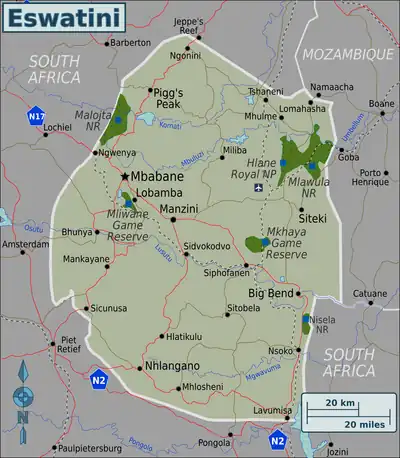
Other destinations
Understand
The Kingdom of Eswatini is one of the last absolute monarchies in the world, one of the smallest countries in Africa and has a well-earned reputation for friendliness in Southern Africa. It also contains several moderately sized game parks and reserves, which are sponsored by the government and are popular tourist destinations.
Eswatini is named for Mswati II, who became king in 1839. The royal lineage can be traced back to the Dlamini clan. The population is divided roughly between Nguni, Sotho and Tsonga, the remainder being 3% white. The current king is Mswati III, son of Sobuza II who had about seventy wives. He rules jointly with Indlovukazi, the Queen Mother. The primary symbol of Eswatini is not what the West would typically associate with nationhood - flags or monuments - but the king himself. The relationship between king and people is demonstrated through the incwala, a ceremony lasting several weeks which focuses on traditional rule, unity of the state, primacy of agriculture, sacredness of land, fertility and potency. Mswati's relationship with his people has been made even more unique through the introduction of chastity decrees for the under-18s to combat the rise of AIDS. However, Mswati III broke the rule when he married a 17-year-old girl, his thirteenth wife, in 2005. Mswati III has come under further criticism for attempting to purchase a private plane during a period of persistent drought and famine. Dissent grew so vociferous that the media was banned from making disparaging remarks about the monarchy, and the plane in particular. In the third year of drought, further plans to build luxury palaces for his wives whilst his people starved led to mass criticism. In 2005, Mswati III signed the country's first constitution though, in effect, nothing has changed: opposition parties remain banned, and the King remains absolute monarch.
Eswatini's main exports are sugar, grown on plantations throughout Eswatini, soft drink concentrates, cotton, maize, tobacco, rice and wood pulp. Demand for asbestos, once a major export, has fallen greatly due to the extreme health risks associated with it. The land is badly overgrazed and overfarmed. This is particularly problematic as Eswatini suffers from persistent droughts. Unemployment hovers at around 25%. This figure is contributed to by inability to work as a result of AIDS.
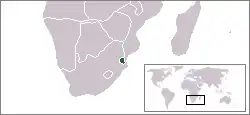 | |
| Capital | Lobamba |
| Currency | lilangeni (SZL) |
| Population | 1 million (2017) |
| Electricity | 230 volt / 50 hertz (BS 546) |
| Country code | +268 |
| Time zone | South African Standard Time, UTC+02:00, Africa/Mbabane |
| Emergencies | 999 (police force), 933 (fire department), +268-977 (emergency medical services) |
| Driving side | left |
| edit on Wikidata | |
Swazis build their huts depending on whether they are descended from Nguni or Sotho: Nguni huts are beehive in shape; Sotho huts have window frames and full doorways. Living space is roughly divided into three parts: living accommodation, animal housing and the 'great' hut, reserved for the spirits of the patrilineal ancestors. Each chief's wife has her own hut. Land is owned by local chiefs or the Crown; much land has been bought back for the nation and unclaimed spaces are used for grazing and collection of firewood. There is a growing class system due to the expansion of the middle classes. Social rank can be determined through the individual's relation to the head of their clan or to the royal family. In urban areas, fluency and proficiency in English is the main social delineator.
There are festivals and ceremonies throughout the year, the most notable being the King's Birthday on 19 April which is celebrated with a national 'day off' and local festivities, and the Reed (Umhlanga) Dance, a three day ceremony which takes place around August when thousands of virgins congregate from all over Eswatini. The King is permitted to pick a new bride from their number.
Compared to other countries in the region, Eswatini is known for its civility and peacefulness, despite similar problems with poverty and one of the world's worst AIDS crises. As of 2018, about 27% of working-age people (age 15 to 49) were infected with HIV. The AIDS epidemic has broken up the traditional extended family unit, leaving many young children orphaned and fighting for survival.
Eswatini is divided into four administrative districts: Hhohho (northwest), Lubombo (east), Manzini (central-west), and Shiselweni (south).
History
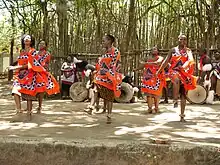
Artifacts indicating human activity dating back to the early Stone Age 200,000 years ago have been found in the Kingdom of Eswatini. Prehistoric rock art paintings date from ca. 25,000 BC. The earliest inhabitants of the area were Khoisan hunter-gatherers. They were largely replaced by the Bantu tribes during Bantu migrations who hailed from the Great Lakes regions of Eastern Africa.
The autonomy of the Swaziland Nation was dictated by British rule of southern Africa in the 19th and 20th centuries. In 1881 the British government signed a convention recognizing Swazi independence. At the start of the Anglo Boer war, Britain placed Swaziland under its direct jurisdiction as a Protectorate. The Swaziland independence Constitution was promulgated by Britain in November 1963 in terms of which a legislative Council and an Executive Council were established. The first Legislative Council of Swaziland was constituted on 9 September 1964. Changes to the original constitution proposed by the Legislative Council were accepted by Britain and a new Constitution providing for a House of Assembly and Senate was drawn up. Elections under this Constitution were held in 1967. Since 1973, Swaziland has seen a quiet struggle between pro-multiparty activists and the monarchy. It gained independence from the UK in 1968.
Climate
Generally speaking, rain falls mostly during the summer months, often in the form of thunderstorms. Winter is the dry season. Annual rainfall is highest on the Highveld in the west, between 1,000 and 2,000 mm depending on the year. The further east, the less rain, with the Lowveld recording 500 to 900 mm per annum. Variations in temperature are also related to the altitude of the different regions. The Highveld temperature is temperate and seldom uncomfortably hot while the Lowveld may record temperatures around 40 degrees Celsius in summer. Pack rain gear for the wet season, including shoes that can handle mud, and lightweight clothes such as shorts for the summer.
Tourist information
- Eswatini Tourism website
Get in
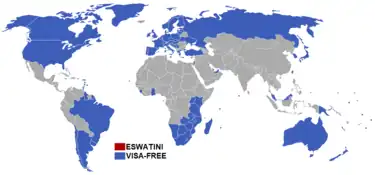
Eswatini's visa policy is quite liberal. Citizens of many countries can visit the country without a visa. The government plans to offer visas on arrival in the near future.
Entry requirements
Citizens of the following countries/territories do not require a visa to enter Eswatini for visits up to 30 days:
Andorra, Antigua and Barbuda, Argentina, Australia, Austria, Bahamas, Barbados, Belgium, Bosnia Herzegovina, Botswana, Brazil, Canada, Chile, Croatia, Cyprus, Czech Republic, Denmark, East Timor, Estonia, Fiji, Finland, France, Gambia, Germany, Ghana, Greece, Grenada, Guyana, Hungary, Iceland, Ireland, Israel, Italy, Jamaica, Japan, Kenya, Latvia, Lesotho, Lithuania, Luxembourg, Madagascar, Malawi, Malaysia, Malta, Mauritius, Monaco, Mozambique, Namibia, Nauru, Netherlands, New Zealand, Norway, Papua New Guinea, Poland, Portugal, Russia, Samoa, San Marino, Serbia, Seychelles, Sierra Leone, Singapore, Slovenia, Solomon Islands, South Africa, South Korea, Spain, Sweden, Switzerland, Taiwan, Tanzania, Tonga, Trinidad and Tobago, Turkey, Tuvalu, Uganda, Ukraine, Uruguay, United Kingdom, United States, Zambia, and Zimbabwe.
Visa requirements
If you need a visa to enter the country, you must submit the following documents to your local Eswatini embassy:
- A valid passport.
- Documentation indicating your intentions to visit Eswatini.
- Documentation indicating the duration of your stay.
- Two passport-sized photographs.
- Proof that you are financially stable (bank statements, salary slips, and the like will suffice).
- Air travel tickets (if you plan to enter the country by plane).
Eswatini has a small number of diplomatic missions. If your country doesn't have an Eswatini embassy, go here and see if an embassy is accredited to your country of residence. Plan and prepare accordingly if your country does not host an Eswatini embassy.
If you are in South Africa, you can apply for an Eswatini visa at the Eswatini embassy in Pretoria. It will take two days to process the visa. For more information, click here.
By plane

The only international airport in Eswatini is King Mswati III International Airport (SHO) also called Sikhuphe (replacing Matsapha Airport, which lied about 1 km north of Manzini, a few kilometres west of the highway linking Manzini with Mbabane). Two airlines use this airport, flying to Cape Town, Durban, Johannesburg and Harare.
There is also a small car rental station at the airport and a snack shop. A hotspot has been installed, allowing users with WiFi and Wireless LAN-equipped computers or other devices to access the internet from anywhere in the building free of charge.
By bus
Most public transport bus services arrive in Mbabane or Manzini. Smaller bus lines, or minibuses generally provide service to Johannesburg, Durban or Cape Town in South Africa as well as Maputo in Mozambique.
Larger buses usually travel within the country and some stop at border crossings, where passengers must connect with an onward journey, unless a specific group booking is done to hire a big bus.
For scheduled road transport there is the Eswatini-based siyeSwatini TransMagnific, which provides transport to and from Eswatini daily. Stops include the Johannesburg airport. The TransMagnific mini-buses are customised for added comfort and safety, unlike the public transport. The size of the minibus is a function of the number of bookings for that trip, so the bus might actually turn out to be painfully uncomfortable. They require that bookings and payments be done at least a day prior to travel so that your meal can be ordered and the selection for the film can be determined for the approximately 5-hour trip. Meals, however, are arbitrarily distributed among the passengers: some get a pack whilst others don't. If the driver crashes into another vehicle on the highway, expect a four-hour delay.
When travelling into and out of South Africa to and from Eswatini, TransMagnific is generally the safest option. All mini-buses into South Africa go directly to Johannesburg bus stations, which can be dangerous.
By car
Depending on season, the border crossings from South Africa to Eswatini can be crowded. The Ngwenya/Oshoek Border Post (on the N17/MR3 from Ermelo to Mbabane) tends to be full of people around long weekends and holidays, since it is the most popular border post. Other border posts, such as the one near Amsterdam (Nerston) and Jeppes Reef are a good alternative and easily reachable with normal 2x4s.
Mahamba border post near Piet Retief is handy when coming from south (Durban) or north-west (Johannesburg). Operations are rather quick. There is a 50 rand road toll.
There might be lengthy checks of your car and/or baggage at the South African border post when leaving Eswatini.
Coming from South Africa, check the Department of Home Affairs for border crossings to verify opening times.
Get around

With an area of 6,704 sq mi, the quickest way to get around the country is by car. You can easily cover the whole country in one day this way.
By bus
Minibuses, called kombis, are prevalent, but can be confusing. Like similar modes of travel around the world such as the jitney, matatu or dolmus, these are small vans that accumulate as many travellers as possible while making their way along a general direction. In Eswatini, these vans are often driven by very young men, and most have assistants who estimate and collect fares, ask your destination, and make change. It is very, very unlikely to be over-charged.
Be prepared for crowded seats, loud radios, and sometimes reckless driving. The larger Sprinter vans are a safer and faster choice if available.
Minibuses can usually be flagged down along main roads. Larger towns usually serve as minibus hubs or connections. Major hubs include Manzini, Mbabane, Pigg's Peak, Nhlangano, Siteki, and Big Bend. Finding the correct bus can be tricky, so discreetly ask if you can't figure it out. The kombis typically have destinations written on the front bumpers. At a bus station (or bus rank), young men will yell out the destinations and are helpful in guiding you to the correct kombi; however, always double check with the passengers. Watch your belongings as such places, like all bus terminals worldwide, have disproportionally higher crime rates. Stay away from these bus ranks at night.
Travel is very difficult after dark. The only option is by taxi. If staying around Mbabane or Manzini, keep a couple of cab drivers' phone numbers on hand. Taxi drivers may overcharge.
By car
Traffic is on the left. The road is partially in good condition and paved. There are sections in poor condition, particularly in the mountains.
The roads are used by a large number of livestock, especially cows and goats, as the roadsides are commonly used for grazing. These animals often pose a hazard to traffic. Driving speeds are very high. Driving after dark should be avoided. On the N4 road from South Africa via the Oshoek border post, avoid driving after dark due to the risk of carjacking. The road across the Eswatini border into Mozambique should also be avoided after dark for the same reason.
Talk
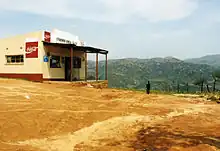
English is the official language of business. It is advisable that travellers learn a little of the local language, SiSwati (also known as Swazi) which, in rural areas, is spoken almost exclusively.
See
The national parks and reserves are the most important sights in Eswatini and traditional culture and customs are still alive - just like in most of Africa.
Do
Volunteer
Eswatini is one of the world's poorest countries, with 59% of the population living below the poverty line.
Volunteering is a great way to explore and learn more about the country and its culture.
Adventure activities
- 🌍 Nsangwini Rock Art Tour, ☏ +268 78121139. Daily. A unique and historic site above the Komati River. R50 per person. (updated Apr 2022)
Buy
Money
|
Exchange rates for Eswatini emlilanegeni
As of January 2024:
Exchange rates fluctuate. Current rates for these and other currencies are available from XE.com |
The currency of Eswatini is called the lilangeni (plural: "emalangeni"), denoted by the symbol "L" for one, or "E" for more than one (ISO code: SZL). It is tied to the South African rand at par, as are the Namibian dollar and Lesotho loti.
Coins of Eswatini come in denominations of 10, 20 and 50 cents, 1, 2 and 5 emalangeni. Banknotes of Eswatini come in denominations of 10, 20, 50, 100 and 200 emalangeni.
Shops in Eswatini usually accept and make change for both currencies indiscriminately where banknotes are concerned, but not coins. However, this is not the case in South Africa, so if you are planning to visit South Africa also, you may prefer to request rand in exchange for emalangeni at banks in Mbabane or Manzini: proof of identity is required. It is impossible to exchange your emalangeni at Johannesburg Airport or in the UK. All Swazi vendors will take rand, but no South African vendors will take emalangeni.
Kombi operators in Eswatini do not take Rand coins.
Shopping
There are small stores where you can buy everything from Swazi foods to Swazi wooden sculptures and handmade bags.
Eat
_op_het_menu_vanavond_(6336544806).jpg.webp)
Many Western foods are available in Swazi grocery stores, but traditional foods are still common, as is modern convenience food based on traditional ingredients.
Maize-based dishes are popular, and mealie or pap (similar to porridge) is a staple. Beans, groundnuts, pumpkin, avocado and sour milk are also common ingredients. Dried and cooked local meats, such as antelope (often called 'wild meat' by locals), are widely available at tourist restaurants.
"Chicken dust" is a cheap local bbq meal; basically chicken grilled in the open served with a salad and mealie. It is popular both with locals and absolutely delicious. Of course, take appropriate precautions as it is a street vendor food.
Sweet breads, vegetables and fruits are often available from roadside merchants. If you're craving pasta, imported olive oil, Nestle chocolate, Herbal Essences and Carlsberg, head over to the Hub, at Manzini: a huge Spar with everything you could need (at an appropriately inflated price). There are several coffee-shops and restaurants around the Hub, also: be aware that the lavatories are located separately, down the stairs, and you have to pay to use them. Manzini's bustling markets and local shops yield all kinds of interesting foodstuffs, along with the ubiquitous KFC.
Drink
Marula (made of fruits from the tree with the same name) is locally brewed during the marula season, fruits ripen between December and March. It may be difficult to find; ask locals as it is home-brewed.
There is a vibrant nightlife in Eswatini ranging from traditional dances to bars and nightclubs. If you're staying in Ezulwini, there are four bars at the Royal Swazi hotel. If you're in the Malkerns area, the House on Fire is extremely popular: local art, local and national DJs, an open-air setting and live acts.
Sleep
Eswatini is a small country and it is easy to get anywhere in the country during one day.
If you're watching the pennies, head to Veki's Guesthouse or Grifter's Backpackers in Mbabane, which costs around E120 per night for a bunk. It is unclear whether the latter one still exists. If you want to push the boat out, book a room at the Mountain Inn which has outstanding accommodation, facilities and leisure opportunities.
The most sought-after hotels in Eswatini tend to be located in Ezulwini Valley between the two major cities, Mbabane and Manzini. (Don't forget to pick up beautiful local crafts from the roadside stalls on the way.) With four bars, a restaurant, a casino, golf, swimming, tennis and 411 rooms and suites, the Royal Sun Swazi epitomises luxury. The Royal Villas, also found in Ezulwini, spread 56 rooms across 14 villas and are extremely luxurious, offering excellent food, atmosphere and leisure facilities. The Ezulwini sun offers excellent facilities, also, at mid-range prices. A budget option is Sundowners Backpackers, private rooms from around E200, dorms from E120 and camping from E70/night.
And, if you're heading down towards the Mozambique border, you'll find comfortable, well-appointed country clubs at Manananga, Mhlume and Simunye.
Learn
Stay safe
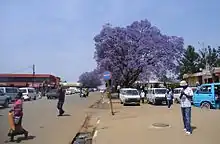
Historically, Eswatini has enjoyed a very low rate of violent crime compared to its neighbors. Indeed, South Africans and Mozambicans love to vacation here because they need not worry about being crime victims while on vacation.
Be cautious in the presence of police. Officers have been known to aggressively apprehend and abuse foreigners for minor offences such as jaywalking or speeding.
Hippopotamuses are found (rarely) in the country's rivers, and are one of the more dangerous animals you are likely to come across. They are actually quite fast animals, as well as being extremely strong and with large, powerful jaws. They often stay submerged in shallow water during the day, but come out at night to graze. They can be unpredictable, territorial and very protective of their young. Do not stand between a hippo and the water.
Crocodiles are a more common danger when swimming in rivers.
Eswatini also has one of the highest numbers of people struck by lightning per capita in the whole world, and it is common to know (or know of) somebody who has been struck by lightning.
Be careful when crossing any of Eswatini's nineteen border gates. It is forbidden to take meat into certain areas, and the soldiers have the right to search both you and your vehicle extensively. It is extremely inadvisable to stray into 'No-Man's Land', a 5 km stretch of territory between Mozambique and Eswatini; several locals have been shot by soldiers guarding the edges of the respective territories.
Whilst physical violence is not prevalent (save on weekends when many may imbibe copious quantities of alcohol), wandering around alone after dark is not advisable, particularly outside Mbabane and Manzini where there is little or no street lighting. Keep your money hidden and, if you are working or travelling in impoverished rural areas, do not eat expensive foods in front of the locals, particularly the children, who, especially if they are AIDS orphans and fed as part of the Sebenta school program, do not get to experience luxury items.
Roads outside of towns are mostly dirt. Roads in towns are heavily potholed. While Swazi main highways are generally in good repair, a four-wheel drive is essential to see much of the interior, unless you wish to be stranded miles from anywhere, with a patchy telephone signal as mobile telephone masts are few and far between. Other drivers, particularly HGVs, often overtake without warning and without checking for oncoming traffic. 'Kombis', local minibuses which function as taxis, drive at a neck-or-nothing rate with more than a full quota of passengers.
Stay healthy
Excellent medical care is entirely non-existent in Eswatini; the country has one of the lowest average life expectancies in the world and the healthcare system is poorly funded and maintained. If you fall sick during your stay, it is recommended that you go to neighbouring South Africa, where medical care is generally better.
Eswatini has the highest HIV/AIDS prevalence rate in the world ― 25-26% of Swazi adults aged between 15-49 have HIV/AIDS ― and it appears that the issue has been getting worse and worse since 2002. Take the necessary precautions and don't even think about having unprotected sex! If you happen to find romance here, which is highly unlikely, you and your partner should consider getting an HIV test before taking things further.
There are risks for bilharzia if you frequent infected streams, as well as seasonal risks for malaria in the North-East parts of Eswatini near Mozambique. Be sure to use mosquito nets and repellent where necessary.
Tap water is potable in major cities but may not be in rural areas.
Respect
Swazis are very loyal to the king and the royalty; be smart about what is said openly.
Eswatini is also predominantly Christian, and modesty in dress is encouraged. Both Western and traditional clothing is worn. Shorts and sleeveless shirts are usually acceptable. The traditional clothing depends upon the person's gender and age. Adults may wear an outfit called emahiya, which is two large pieces of fabric, one tied to cover one shoulder and hang loosely down over the torso, and the other tied around the waist to form a skirt that reaches below the knees. Various accessories indicate the person's marital and social status. Newborns do not wear clothes, and young children wear only a small skirt.
Swazis adhere strongly to their historical traditions, which are widely practised today. Many who are suffering from an illness will consult a sangoma (traditional healer/diviner) to determine its cause and an inyanga (herbalist) to prescribe a treatment. It is the height of disrespect to be disparaging towards these individuals or to refer to them as witch doctors.
Male homosexuality is criminalized in Eswatini, although in practice the law is not enforced. The law does not explicitly discuss female homosexuality. Even still, LGBTQ+ Swazis face common societal discrimination and even violence. LGBTQ+ travellers should be aware that public acknowledgement of their sexuality may put them in legal or extralegal danger.
Connect
Mobile phone coverage is similar to South Africa: even in most nature reserves there is coverage, although it might be weak. There are two wireless operators in Eswatini: MTN-Swazi and Eswatin mobile; the latter's connection is not as good as MTN's. SIM cards from South Africa do not work here (unless it's MTN) and roaming has been enabled. It's easy to buy a starter pack with an MTN-Swazi SIM card, pretty much at every fuel station or grocery store. You must provide proof of residence, ID or passport to get a pack.
Although there is coverage, the phone service is bad: many calls are not connected (or connected to the wrong phone number), SMSs don't arrive, and international calling is more expensive than in South Africa.
Starter pack SIM cards expire within 30 days if not used; they cannot be used in South Africa.